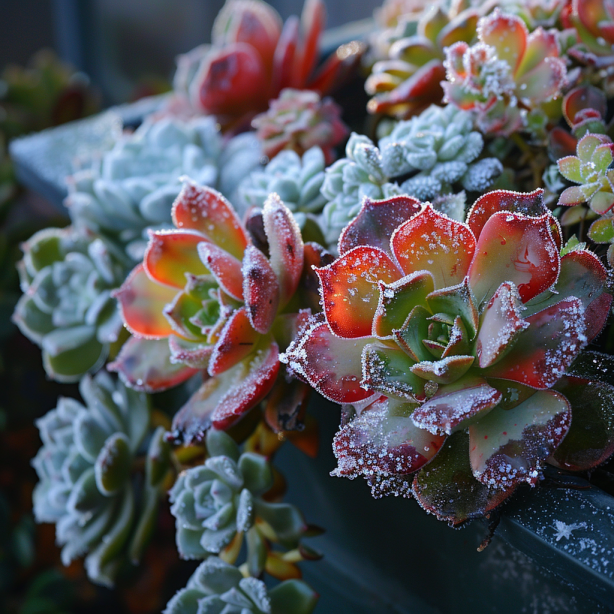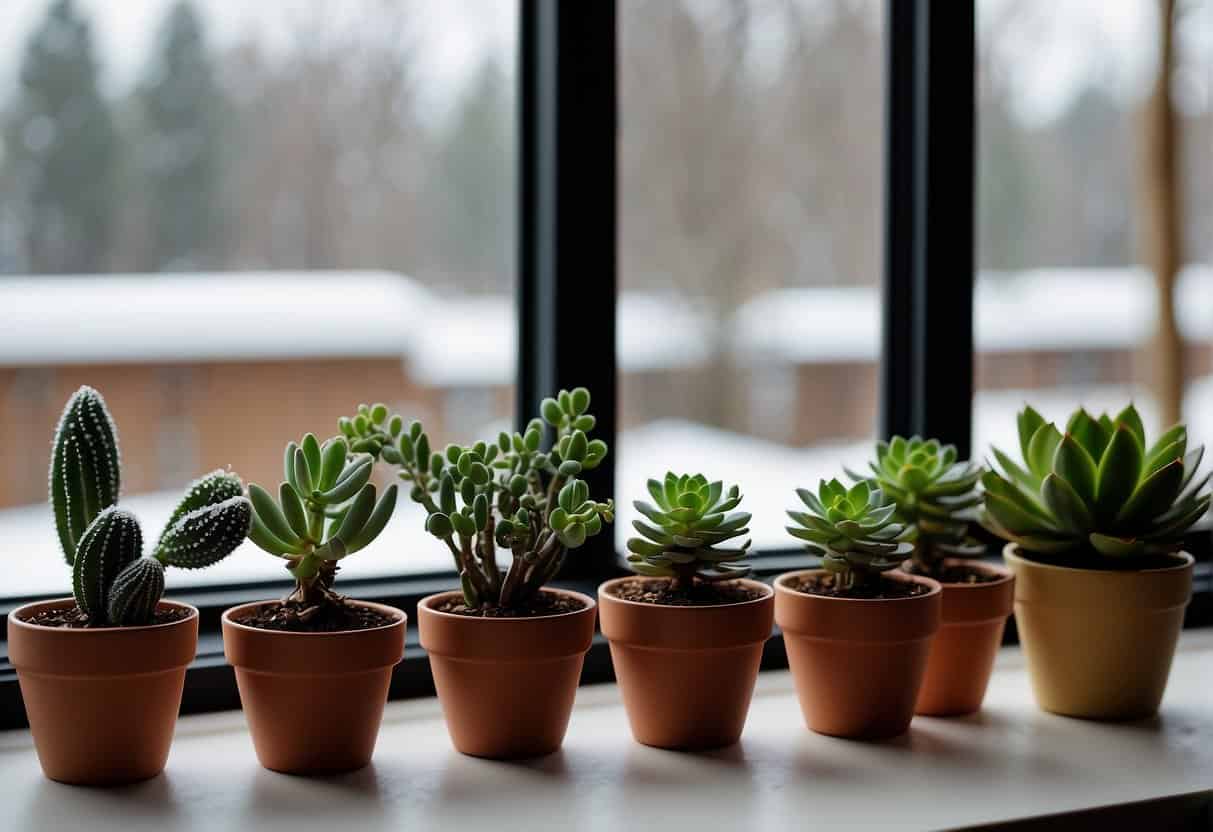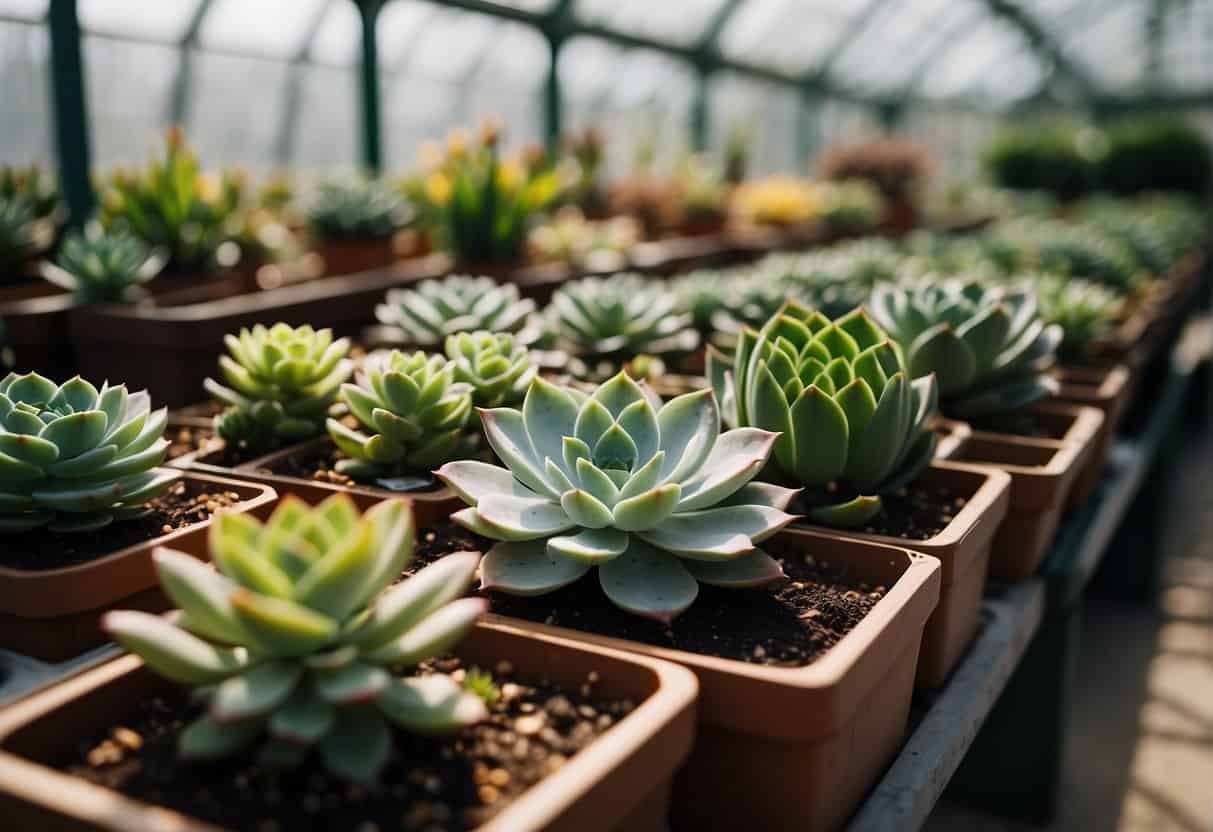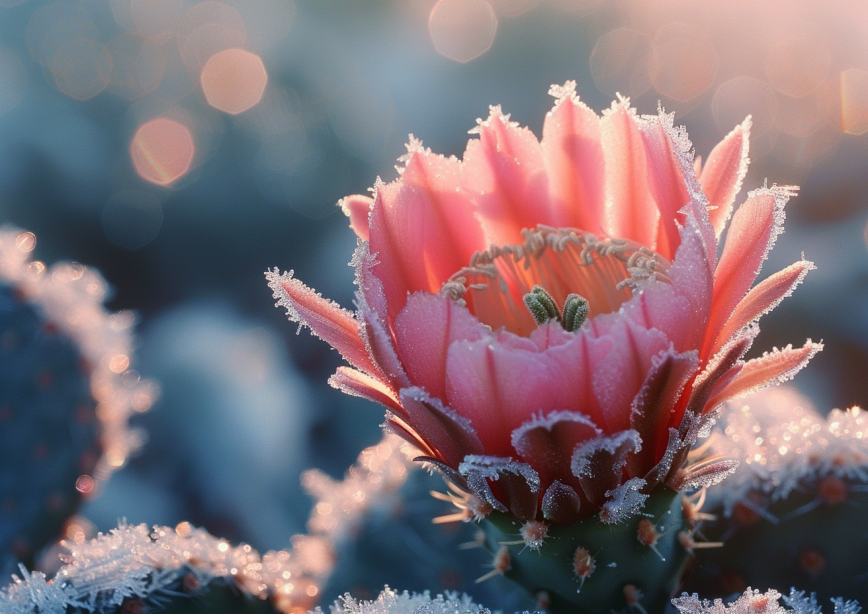Potted succulents have become a focal point for many enthusiasts seeking to maintain the vibrancy and health of these resilient plants through the winter months.
During this time, their care regimen shifts significantly as they face colder temperatures and less sunlight.
Succulents naturally possess adaptations that enable them to survive in arid conditions, but the cooler, darker winter days present a unique set of challenges.
Foremost among these is preventing damage from frost and ensuring that they receive adequate light, which is essential for their survival and continued growth.

To successfully care for succulents in winter, one must pay careful attention to their environment.
While some succulents may withstand lower temperatures, most varieties thrive best when shielded from the cold.
This often involves relocating them indoors or to a conservatory where they can bask in sufficient light and stay away from freezing temperatures.
Watering practices also require adjustment; succulents need less water in the winter months, reflecting their reduced growth rate and the decreased rate of evaporation in cooler conditions.
Overwatering during this dormant period can lead to root rot and other complications.
Providing potted succulents with the right conditions in winter is not just about survival but also about setting them up for robust growth when spring arrives.
Ensuring that they are placed in bright areas, protected from the elements, and watered judiciously are pivotal steps in winter care.
With these measures in place, succulents can not only endure but also flourish during the winter, adding a touch of enduring greenery to the home even in the midst of the colder season.
Understanding Succulent Dormancy
When temperatures drop, succulents enter a phase of dormancy as a survival mechanism.
This period is crucial for maintaining the health of the plants during cold weather.
In this section, we’ll explore what constitutes dormant periods and how to recognize dormancy signs in succulent leaves.
Dormant Periods in Succulents
Succulents, like Sempervivum and Sedum, are adept at conserving energy during winter.
They slow down their growth and metabolic activity to cope with less favorable conditions.
Hardy succulents can withstand freezing temperatures, going fully dormant, while tender succulents require protection from cold weather to survive.
It’s important to adjust care for succulents in winter, as their needs profoundly change during this dormant phase.
Recognizing Dormancy Signs in Leaves
Succulents exhibit visible signs when they enter dormancy.
Leaves may take on different characteristics: some may shrivel slightly and lose their vibrant color, while others, like those of Aloe varieties, remain plump but stop growing.
Signs of dormancy include:
- Hardy Succulents: Leaves may appear desiccated but merely protect their vital resources.
- Soft Succulents: A noticeable reduction in growth rate and leaf size, indicating a reduction in the plant’s metabolic activity.
It is essential not to misinterpret these signs as under-watering or illness; rather, they’re natural adaptations to the cold.
Succulent Care Fundamentals for Cold Climates
Caring for succulents in cold climates demands special attention to watering practices and soil composition. These factors are crucial for the plants to survive and thrive during winter months.
Proper Watering Techniques
In cold climates, succulents require less water than they do during warmer seasons.
They enter a dormant period in winter when their growth slows, and they need minimal moisture.
Watering should be reduced to prevent overwatering, which can lead to root rot due to slower evaporation rates.
One should water succulents only when the soil is completely dry to the touch.
It’s important to water them deeply but infrequently, allowing the water to run out of the pot with drainage holes to avoid standing moisture, which can damage the plant.
Soil and Drainage Essentials
The ideal soil for succulent winter care is a well-draining soil mix, often supplemented with sand or gravel to enhance drainage.
The key is to avoid water-retentive soils that can conserve too much moisture during the cold months.
Using pots with drainage holes is essential to allow excess water to escape, thus preventing the harmful buildup of moisture around the roots.
For cold-hardy succulents, ensuring that the soil remains dry and is not prone to freezing can help mitigate the risk of frost damage.
Indoor Environment Adaptations

Potted succulents face unique challenges during winter, particularly when adjusting to the indoor environment. Careful control of temperature and light ensures their survival and continued health.
Maintaining Optimal Temperature
Succulents prefer a stable indoor temperature range to avoid the detrimental effects of cold weather.
Freezing temperatures and even a light frost can be harmful, necessitating a consistent temperature of around 50ºF.
Effective frost protection for these indoor succulents includes keeping them away from drafty windows and using thermal curtains to create a buffer against the cold.
Sunlight and Artificial Lighting Considerations
A common misconception is that succulents don’t need much sunlight.
In truth, they require ample light to thrive, which becomes sparse indoors during the winter months.
Position succulents near a south-facing window to maximize exposure to natural light.
In cases of insufficient daylight, incorporate grow lights to substitute for the lack of sunlight, ensuring they receive at least six hours of light daily to mimic their natural growing conditions.
Outdoor Winterization Strategies

When temperatures drop, outdoor succulent care during winter requires strategic planning to prevent damage from frost and freezing conditions. The two primary tactics include protecting tender succulents from harsh weather and selecting winter-hardy varieties capable of enduring the cold season.
Protecting from Frost and Freezing
To protect outdoor succulents from the first frost, move potted succulents beneath eaves or into a greenhouse to guard them against freezing temperatures.
In regions with hard frost, it’s critical to relocate outdoor tender succulents indoors before temperatures consistently drop below 32 degrees Fahrenheit.
This preemptive measure helps prevent the detrimental effects of sudden temperature drops.
One can set up plant stands in sunny, sheltered locations to maximize warmth and light exposure, further aiding in the acclimatization of these drought-tolerant plants.
Selecting Appropriately Hardy Varieties
While some succulents are sensitive to cold, hardy succulents like certain species of Sempervivum are well-equipped to handle cold weather, making them excellent choices for outdoor winter gardens.
To ensure successful outdoor survival in winter, opt for varieties that are known to be drought-tolerant and capable of withstanding lower temperatures.
Cacti and other hard succulents often fall into this category, as they are typically more resilient to frost and can sometimes even resist short periods of snow cover.
Choosing the right varieties is a critical aspect of winterizing succulents for optimal outcomes through the colder months.
Preventing Common Winter Ailments

With the arrival of winter, particular attention to potted succulent care can prevent common issues such as rot and pest infestations. Adequate preparation and a shift in maintenance routines protect these resilient plants throughout the colder months.
Avoiding Rot and Overwatering
Rot in succulents is often the consequence of overwatering during winter. As these plants enter a dormancy phase, their water requirements diminish significantly.
Care includes:
- Water Sparingly: Reduce watering frequency to when the soil is completely dry. Feel the top inch of soil; if damp, delay watering.
- Drainage: Ensure pots have adequate drainage holes and use well-draining soil to avoid water accumulation at the roots.
Following these steps minimizes the risk of rot, keeping the succulents healthy.
Managing Pests and Diseases
Winter may also bring about pests and fungal diseases due to the reduced air circulation and humidity indoors.
To maintain a pest-free environment:
- Inspection: Regularly check the leaves and soil for signs of pests or disease.
- Isolation: Quarantine new plants before introducing them to your collection to prevent the spread of pests or disease.
- Treatment: If pests are detected, use appropriate treatments such as insecticidal soap or neem oil.
By monitoring their succulents and responding promptly to signs of distress, owners can keep these hardy plants flourishing even during the winter.
Succulent Pruning and Maintenance

Maintaining potted succulents in winter involves careful pruning of dead or damaged growth and adjusting their feeding to suit the dormant period. These tasks not only keep the plants healthy but also prepare them for vigorous growth in spring.
Pruning Dead Leaves and Growth
During winter, inspecting succulents for dead or withering leaves and growth is essential.
Remove these parts with clean, sharp scissors or pruning shears to prevent decay and pest infestations.
This process also allows the plant to direct its energy to healthier tissue, encouraging resilience against the cold.
- Step 1: Gently remove leaves by twisting them from the stem; only remove leaves that come away easily.
- Step 2: Trim any dead or damaged stems, cutting just above a leaf node or junction.
Feeding and Nutrition during Winter
Succulents require less nutrition in the wintertime as their growth slows down. Overfeeding can lead to nutrient burn and increased vulnerability to diseases.
Therefore, one should halve the frequency of feeding, using a balanced, water-soluble fertilizer, ideally one formulated for cacti and succulents.
- Feeding Schedule: Provide food once every other month or follow specific guidelines for your succulent species.
- Nutrient Balance: Ensure a lower nitrogen content to discourage weak, cold-sensitive growth during this dormant period.
Utilizing Greenhouses and Containers

When winter arrives, the cold can be detrimental to succulents, making greenhouses and well-chosen containers vital for their survival and health.
Greenhouse Benefits for Succulents
Greenhouses provide a controlled environment, which is crucial for maintaining the temperature and humidity levels that succulents need to thrive during colder months.
They also allow for year-round growth by preventing dormancy. Proper greenhouse ventilation is imperative; it assists in preventing pests and diseases that are prevalent in stagnant conditions.
Container Choices to Enhance Protection
Choosing the right containers is equally important for the well-being of succulents in winter.
Plastic containers are lightweight and retain soil moisture, reducing watering frequency. However, ensuring drainage is adequate in these containers will prevent root rot.
Conversely, terra cotta pots are porous, which allows the soil to dry more quickly and is beneficial in preventing overwatering.
Regardless of the material, the container should be proportionate to the size of the succulent to ensure that it is not sitting in excess soil that can hold water and potentially cause harm in the cold weather.
Succulent Species for Winter Resilience

Selecting the right succulent species for colder months can ensure the resilience and vibrancy of your potted garden throughout winter.
Showcasing Cold-Hardy Favorites
Echeveria: These rosette-forming succulents are generally considered cold-sensitive. However, certain species like Echeveria agavoides can tolerate light frosts with proper care. They are best kept in a sheltered area to protect them from extreme cold.
Sedum: Known for their cold-hardiness, many Sedum species are excellent choices for winter climates. Sedum spurium and Sedum reflexum are particularly resilient, enduring freezing temperatures when planted in well-draining soil.
Sempervivum: Often called “Hens and Chicks,” these succulents are among the most cold-hardy. They can withstand below-zero temperatures, making them ideal for colder regions.
Other Hardy Succulents:
- Crassula: The Crassula ovata (Jade Plant) can endure cooler temperatures if kept dry.
- Euphorbias: Many have the resilience for cooler weather, such as Euphorbia myrsinites.
- Haworthia: While not as cold-hardy as some, species like Haworthia cymbiformis can tolerate mild frost.
Exploring Winter-Growing Varieties
Looking beyond those that simply endure the cold, some succulents enter a period of active growth during the cooler months. Known as “winter growers,” these include certain:
- Aloes: Many aloes will grow during cooler periods provided they have protection from severe frost.
- Crassula: Some species like Crassula ovata may show active growth in milder winter climates.
- Dudleya: Native to western North America, several Dudleya species flourish in cooler, wetter winters.
Frequently Asked Questions

In this section, readers will find targeted information answering common concerns about caring for succulents in the chilly winter months.
What is the minimum temperature that succulents can withstand during winter?
Most succulents are resilient but have limits to cold exposure; they generally can withstand temperatures as low as 40°F (4°C). However, exposure to below freezing temperatures for prolonged periods can be detrimental.
How can frost cloth be used to protect succulents from cold weather?
A frost cloth is a beneficial tool that can be draped over succulents during cold nights. It acts as a barrier, trapping heat and reducing the occurrence of frost damage to the plants.
Which succulents are considered cold-hardy and suitable for outdoor winter environments?
Cold-hardy succulents, such as Sempervivum and certain Sedum species, are capable of enduring outdoor winter climates, often surviving temperatures well below freezing.
When is the best time to repot succulents, and does winter affect this timing?
The optimal time to repot succulents is during their active growth period, spring or early summer. Cooling winter temperatures slow their growth, which makes wintertime less ideal for repotting.
What are effective strategies for keeping outdoor succulents alive during the winter months?
Utilizing well-draining soil, providing some coverage from frost, and reducing watering frequency are effective strategies for maintaining the health of outdoor succulents in winter.
Which considerations should be made before bringing potted succulents inside for winter?
Before bringing potted succulents indoors, one should consider light sources, temperature consistency, and pest prevention measures.

